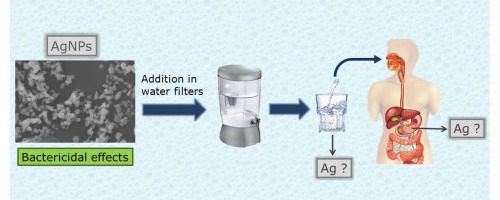
Silver Nanoparticles Drinking Water Purification: Currently, WHO/UNICEF estimated that 783 million people in
the world do not have access to safe drinking water. Its reported 1.87 million childhood deaths are due to waterborne diseases. Conventional water treatment and delivery approaches are considered unfeasible in these
under-developed areas because they need high capital investments, a high cost of maintenance, a high quantity
water source, and these require users to pay for the treated water. People have to collect their own water outside
their homes and then store the water in the household due to the lack of water supply, and contaminations
could occur during the water collection, transport, and storage, which cause a high chance of water-borne
disease infection. A point-of-use (POU) ceramic water filter (CWF) provides an option to purify the water.
Silver Nanoparticles Drinking Water Purification
A ceramic water filter (CWF) is a simple device that can eliminate water-borne pathogens. Currently, CWFs are
manufactured by pressing and firing a mixture of clay and a burnable organic material such as flour, rice husks,
or sawdust before treatment with AgNP [55]. The filter is formed using a filter press, after which it is air-dried
and fired in a kiln. This forms the ceramic material and burns off the sawdust, flour, or rice husk in the filters,
making it porous and permeable to water. CWFs are reported as effective in removing more than 99% of
protozoa and 90-99.99% of bacteria from Silver Nanoparticles in Drinking Water Purification. However, a high
removal of viruses is not achieved.
Silver nanoparticles (AgNO3, Ag+) are added to filters at all CWF factories to achieve higher pathogen removal
due to their antimicrobial properties. The silver solutions are applied to CWF either by brushing or dipping. It
was reported that 83% of CWF factories apply Silver nanoparticles and 17% use Ag+. The concentration of
silver applied at CWF factories varies. Reported amounts of Silver nanoparticles applied on CWFs ranges from
32 to 96 mg per CWF. Current guidelines recommend 64 mg of Silver nanoparticles per CWF. Two mechanisms
of microorganism disinfection by CWFs were suggested. (i) CWFs can remove microorganisms by size exclusion
or adsorption; (ii) Silver nanoparticles or Ag+ inside of CWFs can inactivate pathogens.The bacteria trapped
inside of CWFs coated with AgNP or Ag+.
Silver nanoparticles
Silver Nanoparticles Drinking Water Purification: Water characteristics at the filter user’s home also vary with
location. Previous studies have reported a reduction in antibacterial properties of Silver Nanoparticles in
Drinking Water Purification with increased size of the nanoparticle clusters due to aggregation in the presence
of divalent ions such as Ca2+ and Mg2+. In addition, environmental waters usually contain organic compounds,such as humic acids (HA) [8, 51]. These natural organic matter compounds can rapidly coat the nanoparticle
surfaces, creating a physical barrier that prevents interaction between nanoparticles and bacteria. While previous
studies have reported that different water chemistry conditions can have an impact on the disinfection
performance of AgNP in the aqueous phase[8], these parameters have not been evaluated on CWFs either in the
field or in laboratory tests.
We invite you to contact us for Silver nanoparticles information about our company and our capabilities. If you
want to buy nanomaterials or discuss Oxide Nanoparticles,you can mail us at sales@nanomaterialpowder.com
